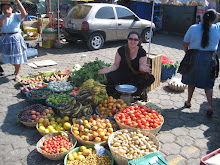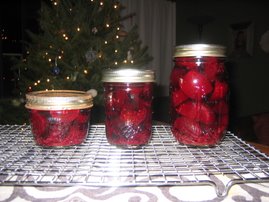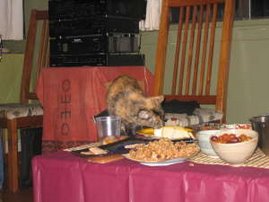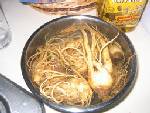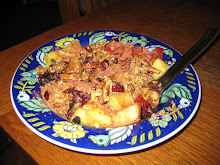
Bees are essential for human life. Without bees, we would die. And without honey, we would be extremely unhappy. The honey pie is possibly the quintessential key to ultimate happiness.
D and I went to our first block association meeting a few weeks ago at the corner pie shop,
Four and Twenty Blackbirds. (Everyone should have a corner pie shop.) The proprietors very generously provided free pie to the group, but when we got there and looked up at the menu we saw something we couldn't pass up: salted honey pie. We weren't going to take a chance that they'd serve us the honey pie, so D went up prepared to buy a slice to share--they gave it to us on the house. It was one of those foodie moments that actually changes your life. And whenever we have that kind of experience, we leave the restaurant thinking; we've got to make this at home. Four & Twenty made this easy by graciously making
their recipe for this divine pie publicly available.

For some reason, D and I started paying a lot of attention to bees. Bees became a theme in our wedding--we had little marzipan bees on our wedding cake, there were bees worked into our wedding invitation, and a friend of D's created a terrific design for wedding-themed frisbees that D gave to his ultimate frisbee friends (pictured here). We even got bee tattoos.
Unfortunately, the honey bee population is in crisis and very few people seem to be paying attention. Check out this documentary,
Colony, about the collapse of the honey bee population. Recently, New Yorkers won the right to keep raise bees in the city. I've thought about doing it, but haven't fully assessed whether I have the wherewithall to make that kind of commitment. There's a course offered here at the
Beekeeper's Association that I'm thinking about taking.
So what do we do in the meantime? We are careful about the kind of honey we buy and we try to support local honey producers so that they remain profitable and keep doing what they're doing. There's been a raging scandal in the food community about honey that most people don't even know about: the honey that you buy at the supermarket is probably not honey at all. You can read about the
scandal here, and take action by seeking out local honey producers. Because you can raise bees just about anywhere, you can even find
locally-produced honey in Brooklyn!

You have to make a recipe dozens of times before you get it perfectly right, so D and I have started the process. The recipe we used calls for one ingredient that you may never have heard of, I know I hadn't:
vanilla bean paste. It's a bit pricey, but you don't need a lot of it. I found it at my new favorite place, the
Albany Food Co-op. Two weeks ago, on our way out to our friends' country house, we decided in the car that we wanted to try to make the honey pie for the first time, but I had left the recently-purchased vanilla bean paste at home. We were prepared to substitute extract, but were delighted to find that our friend stocked vanilla bean paste in his cupboard. (I wonder what he uses it for?) Another key ingredient is salt flakes.
Maldon is the best kind of flaked salt; don't try to substitute another kind, it won't work. The last key ingredient is, of course, good honey. We went to the
Hamlin Buffalo farm and picked up some locally-produced honey (and some buffalo short ribs!) and made this pie.
Salted Honey Pie(Makes one 9-inch custard pie)
Preheat oven to 350F. Have prepared one pre-baked pie shell of your choice, the recipe for the Four & Twenty Blackbird pie crust is below.
For filling1/2 c butter melted
3/4 c white sugar
2 Tbsp white cornmeal
1/4 tsp salt
3/4 c honey
3 eggs
1/2 c cream
2 tsp white vinegar
1 tsp vanilla paste
1 or 2 Tbsp flake sea salt for finishing (Maldon is a good choice)
–
All of the mixing can be done by hand. Melt butter and combine with the sugar, salt and cornmeal to make a thick paste. Add the honey, vanilla and vinegar and mix together. Fold in the eggs, add the cream and blend. Pour the filling into a pre-baked pie shell and bake at 350 F for 45 to 60 minutes. The filling will puff up like a marshmallow and the center will be just slightly wobbly. Once cooled (at least one hour), finish with a sprinkling of flake sea salt. Slice and serve with freshly whipped cream.
 Four & Twenty Blackbirds Pie Crust
Four & Twenty Blackbirds Pie CrustThis recipe makes one double crusted, 9-inch pie (you only need one crust for the honey pie--if you make both, you can freeze the other one).
2 1/2 cups all-purpose unbleached flour
1 teaspoon salt
1 tablespoon sugar
1/2 pound (2 sticks) cold unsalted butter, cut into 1/2-inch pieces
8-10 tablespoons ice water with cider vinegar, or more as needed (combine 1 cup cold water, 1/8 cup cider vinegar and ice)
Whisk the dry ingredients together and blend with a hand-held pastry blender (or a knife and fork or two forks) the chopped, cold butter, being careful not to overwork during this step. The butter should be in pea-sized chunks, not too big, but not completely incorporated. Slowly add the ice water and vinegar mixture and bring the dough completely together by hand, again being careful not to overwork. Aim to create a marbleized effect, so that the butter is still visible. Divide into 2 discs, wrap in plastic and chill 1 hour or more before use. To pre-bake a crust for a custard pie: Roll one disc of crust out to fit a 9-inch pan, about 1/4 inch thick. Place in a buttered pie pan, and crimp the edges as desired. Allow to rest and cool in freezer or fridge for at least 20 minutes. Line the rolled-out crust with tinfoil or unwaxed parchment paper, add pie weights or about a cup of dry beans if you don’t have pie weights. Distribute them evenly. Bake in a 375 F oven for 20 minutes. Allow to cool slightly before filling with custard.

 My blog has been heavy on the meat and sweets lately, so I thought I'd bring it back to the roots and showcase a late-winter vegetable I found at the 5th Avenue Farmer's Market last weekend. Kohlrabi is a tuber-like vegetable that grows above-ground and is rich in vitamins and fiber and very low in calories--despite it's sweetness. There are a number of varieties, but the guy at the vegetable stand gave me a little slice of the purple kohlrabi to try, and I was sold. Kohlrabi is best to buy when the bulbs are relatively small, no more than 1 1/2 inches in diameter. They'll keep in the fridge for a week or so, but they are harder to grate the older they get.
My blog has been heavy on the meat and sweets lately, so I thought I'd bring it back to the roots and showcase a late-winter vegetable I found at the 5th Avenue Farmer's Market last weekend. Kohlrabi is a tuber-like vegetable that grows above-ground and is rich in vitamins and fiber and very low in calories--despite it's sweetness. There are a number of varieties, but the guy at the vegetable stand gave me a little slice of the purple kohlrabi to try, and I was sold. Kohlrabi is best to buy when the bulbs are relatively small, no more than 1 1/2 inches in diameter. They'll keep in the fridge for a week or so, but they are harder to grate the older they get. Purple Kohlrabi Winter Slaw
Purple Kohlrabi Winter Slaw




